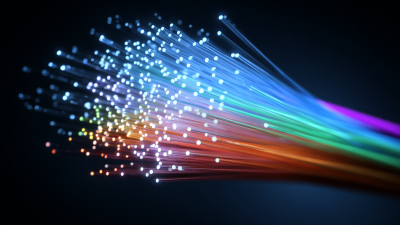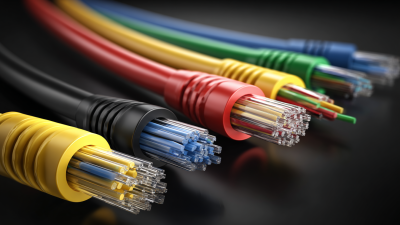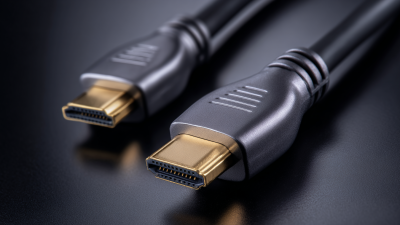Industries
Get direct access to our extensive portfolio of optical products and specialist technical expertise.
Get direct access to our extensive portfolio of optical products and specialist technical expertise.
In today’s fast-paced digital landscape, the importance of a reliable and high-performance network cable cannot be overstated. As per a recent report by the International Data Corporation (IDC), global data traffic is expected to grow by over 20% annually, pushing organizations to seek advanced cabling solutions to support their increasing connectivity demands. The 2022 Connectivity Benchmark Report highlights that businesses leveraging superior network cable technology experience up to 50% improvement in network speed and reliability. Consequently, investing in the right network cables not only enhances connectivity but also future-proofs an organization's infrastructure against the rising tide of data needs. This ultimate guide is designed to explore various advanced network cable options, equipping you with the knowledge to make informed decisions that optimize your networking capabilities.

When it comes to optimizing network performance, the choice of cable can make a significant difference.
Cat6 and Cat7 cables have emerged as popular options, thanks to their capacity to support
faster data transmission rates and improved performance. According to a report by the International Telecommunication Union (ITU),
Cat6 cables can deliver speeds of up to 10 Gbps over distances of 55 meters, while
Cat7 cables can sustain similar speeds over longer distances, up to 100 meters.
This capability makes them ideal for high-bandwidth applications, such as video conferencing and large file transfers.
Moreover, the shielding techniques utilized in Cat7 cables further enhance their performance.
With a greater level of protection against electromagnetic interference (EMI) and crosstalk, Cat7 cables exhibit a reduced error
rate, which is particularly crucial in dense network environments. A study by the Institute of
Electrical and Electronics Engineers (IEEE) found that installations using Cat7 cables experienced a
50% reduction in interference compared to Cat6 installations. This means that businesses
seeking to maximize their network reliability and speed should strongly consider upgrading to
Cat7 cabling, ultimately leading to a more
stable and efficient connectivity experience.

As the demand for high-speed internet continues to rise, fiber optic cables are emerging as a revolutionary solution to enhance connectivity. Unlike traditional copper cables, fiber optics utilize strands of glass or plastic to transmit data as pulses of light. This technology allows for significantly higher bandwidth and faster speeds, making it an ideal choice for both residential and commercial applications. With fiber optics, users can experience seamless streaming, lag-free gaming, and efficient data transfer, all of which are essential in today’s digital age.
Furthermore, the durability and longevity of fiber optic cables set them apart from conventional wiring. They are less susceptible to interference from electronic devices and environmental factors, ensuring a more stable connection. Additionally, fiber optic installations require less maintenance over time, which can lead to cost savings for businesses and homeowners alike. As we move toward an increasingly interconnected future, understanding and adopting fiber optic technology will be crucial in achieving optimal network performance and reliability.
| Cable Type | Max Speed (Gbps) | Max Distance (m) | Application | Cost per Meter ($) |
|---|---|---|---|---|
| Fiber Optic | 100 | 3000 | Internet Backbone | 0.80 |
| Cat6 | 10 | 55 | Local Network | 0.20 |
| Cat6a | 10 | 100 | Data Centers | 0.30 |
| Coaxial | 5 | 500 | Cable TV | 0.15 |
| Single-Mode Fiber | 100 | 50000 | Long-Distance Communication | 1.00 |
When it comes to optimizing signal quality in network installations, understanding the differences between shielded twisted pair (STP) and unshielded twisted pair (UTP) cables is crucial. STP cables incorporate a shield that protects the twisted pairs from electromagnetic interference (EMI), making them ideal for environments with high interference, such as industrial settings or areas with numerous electronic devices. This additional layer of protection helps to maintain signal integrity over longer distances, resulting in fewer data transmission errors and improved performance for high-bandwidth applications.
On the other hand, UTP cables offer a more cost-effective solution for many networking situations, particularly in residential or office environments with minimal interference. While UTP cables lack the shielding found in STP, they are still capable of delivering reliable performance for most everyday applications. Their flexibility and ease of installation make them a popular choice for businesses looking to establish robust networks without incurring excessive costs. Ultimately, the choice between shielded and unshielded twisted pair cables depends on the specific needs of your network and the environment in which it operates.
Selecting the right network cable length is crucial for optimizing your connectivity and ensuring efficient data transmission. According to a report from the Institute of Electrical and Electronics Engineers (IEEE), using the correct cable length can significantly reduce latency and packet loss. For instance, Ethernet cables achieve maximum performance over shorter distances, with Category 6 cables recommended for lengths up to 100 meters to maintain speed and reliability.

When determining the appropriate length for your setup, consider both current and future needs. The telecommunications industry indicates that as network demands grow with more devices connecting to the internet, adopting slightly longer cables can provide flexibility for rearrangements without compromising performance. A study by the Network Cabling Services reported that 40% of businesses experience connectivity issues due to improper cable management. Therefore, measuring your space thoughtfully and allowing for extra length, such as 10-20% more than the distance between devices, can enhance your setup’s scalability and performance.
In today's digital landscape, optimizing your network capabilities is essential. With the emergence of innovative accessories designed for advanced network cables, you can significantly enhance your connectivity. One promising option is the Power over Ethernet (PoE) technology, which allows for power and data transmission through a single cable. Recent advancements, such as those seen in the Raspberry Pi 5 and its dedicated PoE network HAT, exemplify how these accessories can streamline installations and reduce clutter.
When considering network cable options, one valuable tip is to look for compatibility with high-speed performance features like the 5 Gbps PoE+ solution. This not only improves data transmission efficiency but also supports connected devices without the need for multiple power sources. Additionally, investing in quality cable management accessories can protect your cables from damage while enhancing the overall aesthetic of your workspace.
Moreover, as the medium voltage cables market continues to grow, focusing on advanced cable types can increase reliability and safety in your electrical systems. Harnessing these innovations ensures that your network setup remains cutting-edge and resilient, helping you meet the ever-increasing demands of connectivity in both personal and professional environments.





